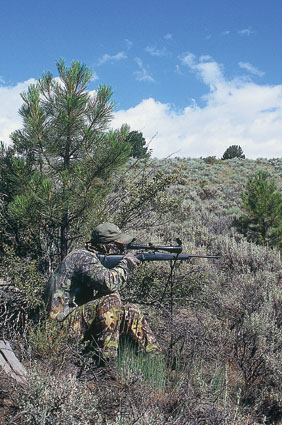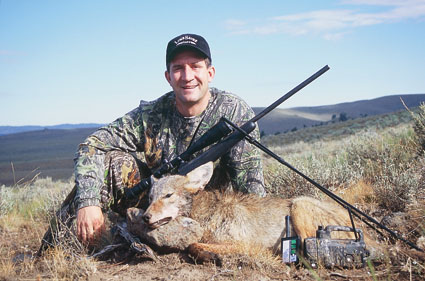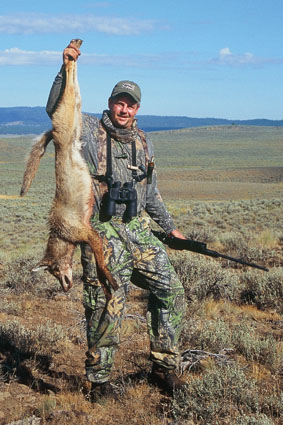 Coyotes can occupy a wide range of habitat in the summer, and hunters have to ask, am I looking in the right place? Concentrate in creek and river bottoms, where cool, shaded terrain makes for comfortable living this time of year. River habitats are usually teaming with food, from rodents to rabbits, birds, deer, crustaceans and carrion that have washed ashore.
Coyotes can occupy a wide range of habitat in the summer, and hunters have to ask, am I looking in the right place? Concentrate in creek and river bottoms, where cool, shaded terrain makes for comfortable living this time of year. River habitats are usually teaming with food, from rodents to rabbits, birds, deer, crustaceans and carrion that have washed ashore.
One summer I watched a coyote pull a salmon from a pool. The salmon was battle-scarred, but still full of life. The 20-pound fish gave the coyote a tussle, but the canine won, and wasted no time feasting in the midday sun, on the open rocks of a gravel bar.
Valley floors also hold a great deal of coyotes in the summer. As with high desert habitats, valley floors are often sights of farming and ranching activity, both of which attract food sources that coyotes thrive on such as insects, mice and squirrels. The key here can be finding landowners willing to grant hunting permission.
It's been my experience that ranches that have big-game animals dropping fawns on the property—namely deer and antelope—are generally receptive to summertime coyote hunting. The caution has to be in attention to where their livestock may be ranging at the time you want to be hunting.
Summer is also a good time to go high. Many coyotes are vertical migrators, just like deer and elk. They move up and down in elevation with the changing seasons. During the summer months, there's plenty of food up high. From grasshoppers in mountain-meadows to mice, voles, deer fawns, elk calves and more, there's plenty in the high country to keep a pack of coyotes thriving, but they have to work for it.
I've got into summer coyotes near the 10,000-foot mark in the Rocky Mountains, at 3,000 feet in sagebrush desert, and all the way down to the 500-foot elevation mark in valley floors. All habitats offer ample food this time of year, and good action for eager hunters.
Summer Time Calls
At the high elevations, especially in timber, distress sounds and calf elk calls have proven effective over the years. I believe this is because—though there's ample food in these zones—the coyotes have to work for it in order to appease the tenacious appetites of a growing pack. They will still respond to a distress sound, simply because they associate it with an easy opportunity.
 While coyotes seem to respond more readily to distress sounds at higher elevations, at lower climbs, consider speaking their own language for desirable results. I use the word desirable, rather than best, because this is a selective time to hunt. You can bring young coyotes in fairly easy with distress sounds this time of the year. They are pretty curious and not yet call savvy, but what about the adults?
While coyotes seem to respond more readily to distress sounds at higher elevations, at lower climbs, consider speaking their own language for desirable results. I use the word desirable, rather than best, because this is a selective time to hunt. You can bring young coyotes in fairly easy with distress sounds this time of the year. They are pretty curious and not yet call savvy, but what about the adults?
"Adult coyotes, especially females, have a strong parenting instinct this time of year, which means they’re very responsive to coyote vocalization," shares Aamodt, owner of Diamond A Guides, in the high desert country of eastern Oregon. "All the food they need is available this time of year, which means you can forget about distress sounds."
Aamodt's summer time calling sequence starts with three male interrogation howls, followed by three minutes of silence. If a coyote does not answer back, he'll try a female interrogation howl, then wait.
"By starting with dominant male interrogation howls, you're targeting males and aggressive females," shares Aamodt. "The purpose is to get them fired-up about protecting their area from an intruder."
If the female interrogation howl fails to bring a response after three minutes of silence, Aamodt will go to a young pup distress sound and wait for five minutes. The purpose of this call is to make the adults think something has happened to one of their own. If no response, repeat the entire sequence two or three more times.
"I'd rather save the varmint distress sounds for a few months down the road, when the pups have matured and their pelts filled out," points out Aamodt. "I also don't want to pull all of the tricks out of the bag this early in the season, for if they grow educated at this point, I won't have anything new to offer them come fall!"
So what happens if a coyote does respond to the first series of calls? "You'll usually get a serenade response from two or more coyotes this time of year, you'll even hear the pups' raspy voices in the background," notes Aamodt. "But as soon as I hear that deep voice of a male, or a mature female, I'll answer right back, over the top of them, with whatever I started with that drew the response. If it was a male interrogation howl, that's what I'll come back with."
Aamodt's approach is to send a message that conveys, "Hey, I'm here, I know you're there and I'm holding my ground!" At this point, it's not a challenge, but if the coyote answers back, get ready.
 "If he answers the comeback call, it's usually in the form of a challenge, which is a shorter howl with a series of barks that follow," says Aamodt. "Listen to what the coyote is telling you, and respond accordingly. In this case, I'm going to come right back over his voice and challenge him with the same calls. I want him to know I'm not giving in. This might go on two or three more times, then stop. Once there's silence, get ready, because he's usually coming in fast."
"If he answers the comeback call, it's usually in the form of a challenge, which is a shorter howl with a series of barks that follow," says Aamodt. "Listen to what the coyote is telling you, and respond accordingly. In this case, I'm going to come right back over his voice and challenge him with the same calls. I want him to know I'm not giving in. This might go on two or three more times, then stop. Once there's silence, get ready, because he's usually coming in fast."
What if neither the male or female interrogation howl got a response, but the coyote pup distress worked? In this case, Aamodt recommends coming right back with an immediate howl, to state dominance and aggression. "I think the pup distress sound triggers that parenting instinct that's so strong in summer, and sometimes this really gets the adults going. They'll often come in full speed, without making a sound."
If none of the calls work after two to three series, or 15-20 minutes, it's usually time to move on. However, there are exceptions. Last year Aamodt knew a big male was in the area, so kept calling. It took over an hour, but the big dog came in and was met with a hot-shooting .204.
From now until first freeze is a good time to use this calling approach. After that initial freeze, the pack seems to start going its separate ways as the pups continually become more independent.
"This is a great time of year to call because you know which direction they'll be coming from," concludes Aamodt. "They are really vocal now, as they are when mating season is coming on. The benefit is knowing where they're approaching from so you can set up for the shot without being detected."
There are several good hand calls on the market today, but the Primos Little Dog is easy to use and has worked well for me. Aamodt also believes this is a simple howler to blow. However, hand calls aren't for everyone, especially when emulating yapper chat, which can get tricky. This is where digital calling systems come in handy. A flick of the switch allows you to change sounds, and you're ensured of getting the same, consistent sound every time.
On one of my last summer coyote hunts, I set up in big timber and worked a small meadow in front of me. The wind was at my back, blowing directly into the open space. It was perfect, for any approaching dog would surely circle downwind, into the opening. It worked. Though he came in silent, my .204 dropped him in his tracks.
In states that allow it, summer is a prime time for coyotes. This is when they come in most aggressively—barking, snarling, hackles up, popping their teeth. It's their parental instinct, and knowing how they respond will make you realize, there is no downtime when it comes to hunting coyotes.






